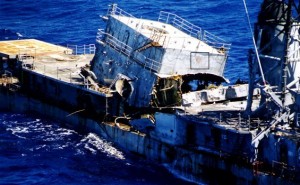 Chris Cavas assembled a good summary of AirSea Battle this week….Despite all the hype and it’s grand-sounding strategic template, AirSea Battle is a simple concept that aims, in large part, to better enable Air Force and Navy collaboration to support prosecution of naval warfare. It’s about efficient and seamless utilization of resources. A simple alignment of available strike force to better confront emergent national security priorities (and lower budgets).
Chris Cavas assembled a good summary of AirSea Battle this week….Despite all the hype and it’s grand-sounding strategic template, AirSea Battle is a simple concept that aims, in large part, to better enable Air Force and Navy collaboration to support prosecution of naval warfare. It’s about efficient and seamless utilization of resources. A simple alignment of available strike force to better confront emergent national security priorities (and lower budgets).
That’s it.
It’s nothing to get excited about. But you gotta wonder….with the amount of ink spilled on AirSea Battle since B-52s started getting invited to SINKEXes back with, oh, the 1998 missile-shooting of the ex-SOMERS (DD-947) (see the pic at right), one might think we were doing something earth-shattering. (Like drone warfare, for instance…)
AirSea Battle, at it’s heart, is simply trying to avoid a repeat of the Air Force’s poor performance in, say, the Cuban Missile Crisis. When the Air Force offered to help the Navy with target identification, boasting their boys could identify all Soviet shipping in the search area within four hours, the results were, according to Michael T. Isenberg’s Shield of the Republic, “unilluminating”:
Several Air Force B-52s and RB-47Ks and sixteen KC-97 tankers began flying search patterns in the mid-Atlantic. Soon they began to radio back their reports, identifying American, British and Greek freighters as Russian. Their classic gaffe came when they reported several ships as Russian, due to the telltale red star on their stacks. Those turned out to be Texaco tankers on their routine rounds.
“What in hell does a SAC bomber crew know about ships at sea?” exploded one of Dennison’s staff officers, “much less a SAC tanker crew.” Even in the midst of the greatest nuclear crisis in the nation’s history, the wars of the fathers raged on…
The seam between the Air Force and the Navy/Marine Corps is long-standing. We (and our rivals) need only look back at the first Gulf War to see how that seam might be exploited…But, as both Services shrink, it makes sense to bury the hatchets and get about the profitable business of working together…just keep it simple, avoid over-reach and do it right.
Don’t get me wrong…there IS a lot at stake here. AirSea Battle, if successful in smoothing out inter-service coordination, will ease the full-scale incorporation of unmanned aerial platforms into the battle-space. But that’s a job for the Son of AirSea Battle. AirSea Battle should keep it simple, and do well achieving limited, clear goals. Save the flowery doctrine for later.
As a side-note–does anyone understand why the Army waited until 2012 to participate in this? It was obviously a money-maker, and all Army leadership had to do was to march down to the SECDEFs office and detail foundations set in the Gulf–where Joint Army/Navy Hunter/Killer groups of Army OH-58D Kiowa Warriors and Navy LAMPs have done great work slaughtering small watercraft and neutralizing coastal defense structures.
